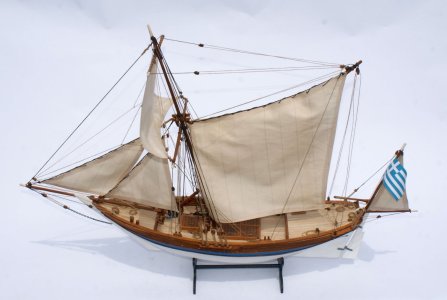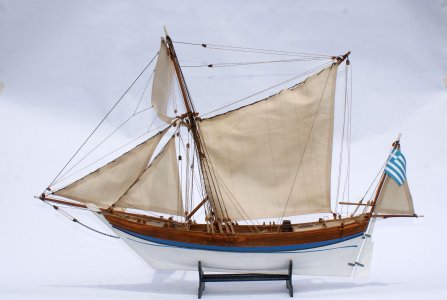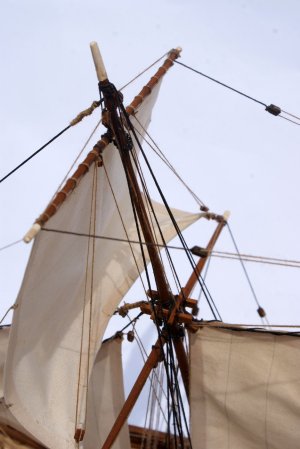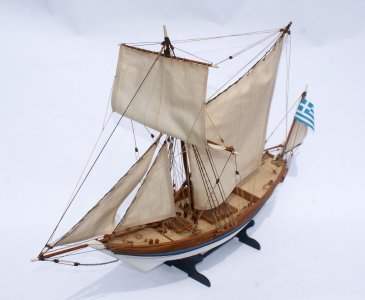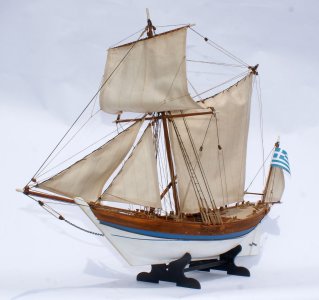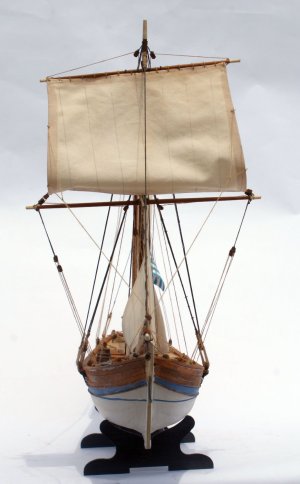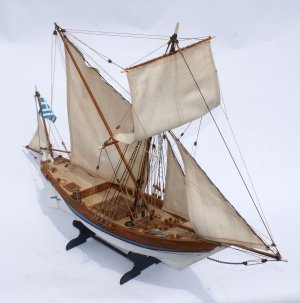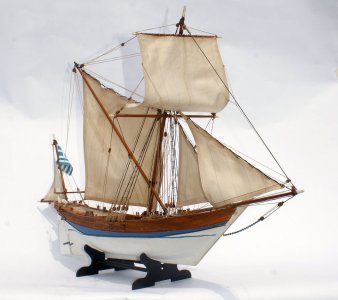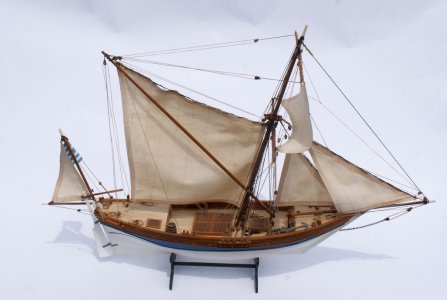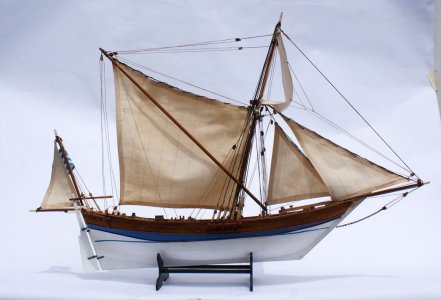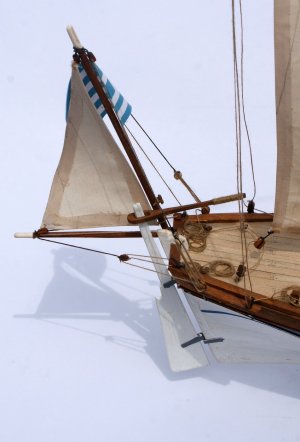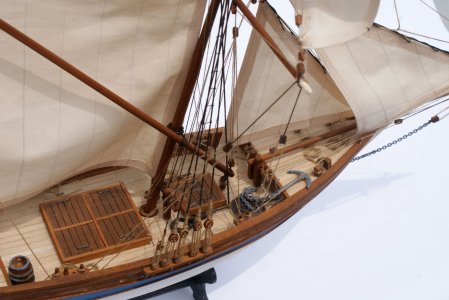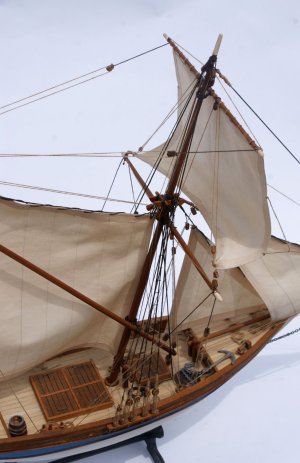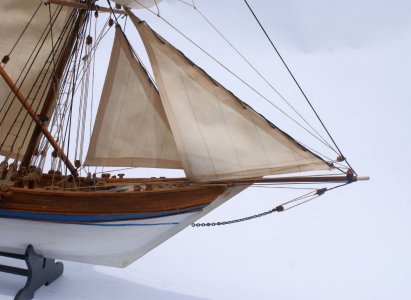After an exhausting 14-hour flight, I arrived in Stockholm and I will take advantage of this weekend to visit (again) the Vasa Museum with my grandchildren, while I present to you the model of a ship that I made a couple of years ago.
TSERNIKI-SACOLEVA (1 rst Part)
Introduction
“From the 18th century to the first half of the last century, it was easy to find ships with unmistakable rigging, the main component of which was a large tarquin sail (tarchia), in the eastern Mediterranean, on the southern coast of Anatolia, Syria and Egypt, and in the Black Sea and the Adriatic. And anyone who knew one of them could get an “unforgettable impression”; it is really scary when a strong wind blows and all the ships cautiously take the reefs; to see them sailing at full sail, overcoming the waves like a thoroughbred horse jumping over the hedge, running so fast in the wind that it makes you think it can no longer right itself... ". These lines are from Auguste Jal. What Captain Henrique said about it "...Greek sailors are deservedly considered among the best in the world, and one feels that they passionately love their ships and their trade; On the schooner there is a mast with large sails and it is very fun to see them from a distance, as they deceive the eye and look like things from a fairy tale. 15-meter boats (the size of the lifeboats of the great ships of the past) are equipped with several sails, double topsails, foresails, three or four jibs, this little boat that looks like a nutshell, wants to look like a three-deck ship and triumphs in its small size with a captivating grace…"
This is how the article "La Sacoleva" by Sergio Bellabarba and Girgio Osculati begins, where this beautiful boat is described in detail, its history is narrated, its usual dimensions, the use it had, as well as the name that in some places it was given: Tserniki, Sacoleva, Sakoleva or Sacoleve (so named by Vice-Admiral Paris in his book Souvenirs de Marine. Collection de Plans ou Dessins de Navires).
For the purposes of this project, the plan GRECE-SACOLEVE-1835 by Vice-Admiral Francios-Edmond Paris has been taken as a basis, as well as details of the article "La Sacoleva" by Bellabarba-Osculati, and others from the references mentioned here
References
 "Atlas du Genie Maritime" par les officiers de ce corps A Toulon" Volume 1
"Atlas du Genie Maritime" par les officiers de ce corps A Toulon" Volume 1
Making the model
The first photo shows several ships anchored in port, in one of them you can see the main mast vertically with the yards with sails furled; in the other photo a schooner without a mizzen; then, the rigging was variable and depended a lot on which part of the Mediterranean or Adriatic the ship was. The other photos are the beginning of the article "The Schooner", it is in Italian, but with some effort it was possible to extract details. Also included is the plan of the "Atlas du Genie Maritime" that was used as a base.
From the plans shown and their hull lines, the sections for the frames were obtained, from the plan view, the shape of the deck and the dimensions of the rigging. It was drawn in AutoCAD and the frames and main parts were laser cut on 4 mm and 1.5 mm plywood sheets, The dimensions of minor elements were taken to the scale of the same plans.
For the hull, 2x5 mm cedar planks were used and glued onto the frames. As the plans don't show much detail, by mistake the planks were made to reach the keel, but the ship should have been a flat mirror, which was rectified. 3x5 mm wooden strips were glued for the sternpost, keel and stem. Afterwards, the hull was brushed and sanded to eliminate protrusions and differences between the planks.
After a good sanding, it was sealed with a mixture of wood putty, shavings and white rubber, filling the joints and deficiencies of the first skin; The hull was then sanded with 100, 150 and 225 grit sandpaper and before the painting phase, a thinned lacquer was applied to stabilise the seal. After sealing the hull with lacquer, the entire surface was lightly sanded and the topsides were painted with several coats of white and light blue acrylic paint, leaving a strip of wood previously stained in mahogany.
The planking was made with 0.6x3x75 mm strips cut from a lupuna veneer which is a whitish local wood. The edges were blackened with pencil lead and glued to the deck piece in a 2-by-2 arrangement; the nailing was simulated with the tip of a hard pencil, then sanded and aged with "Judean bitumen". The hold entrances were prepared and glued to the deck. The gunwale, the gunwale cover (2x5 mm), and the garrison tables were also prepared and fixed, all of them stained in mahogany. The length and variation in diameter of the masts were measured, and the mizzen, mizzen boom, mainmast, bowsprit, yards and yardarm were prepared, all of the pieces were stained in mahogany; some ends were painted in white. 1mm mahogany-coloured strips were placed on the sides of the hull
Then the other deck elements were prepared, such as the garrison tables, bitts, jacks, cleats, chain chinstrap, etc. All the wooden elements were stained honey-coloured. For the sails, the dimensions of the available plans were taken, giving them a margin for the fold, these were prepared with cotton cloth, dyed with tea. The seams were simulated with lines drawn with a pencil and the edges were reinforced with a cotton thread. Two jibs were made, a topsail, a tarquin and the mizzen jib.
The topsail was first placed on the already fixed yards, the two stays were installed towards the bowsprit and the two jibs were mounted. The plans available for this boat are not sufficient; they can be used to make the hull, deck and masts, but they are vague and uncertain in the placement of the ropes, stays, shrouds in the rigging, and in the fixing of the yard. Regarding this point, I have to thank Javier Barón who illustrated me with some diagrams that I used in this model.
After fixing the yardarm, the tarquin sail and other elements were mounted on the masts. We used two gauge thread, one thick for the stays and shrouds, made of braided cotton that was darkened and waxed with Judea bitumen, the other of undyed beige cotton that has been used for the ropes. The shrouds were installed by fixing them to the beams and checking again the alignment and inclination of the masts. Finally, the rudder blade and tiller were placed at anchor with its chain and rope. The final touches of paint were applied.
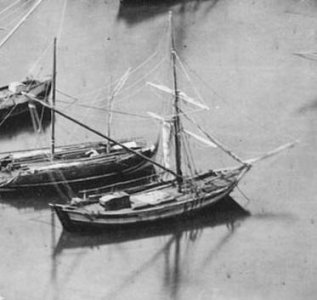

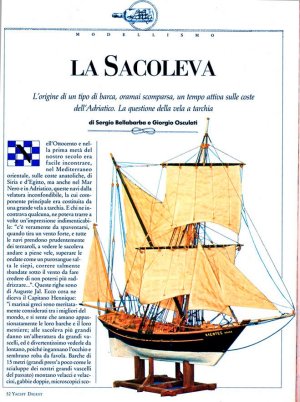
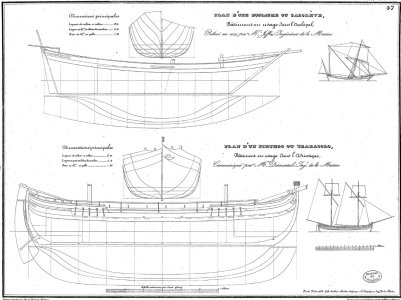
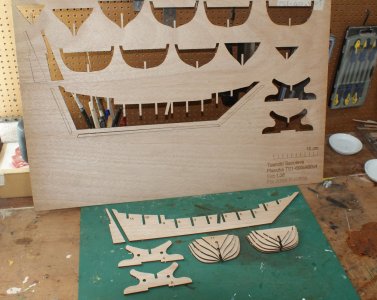

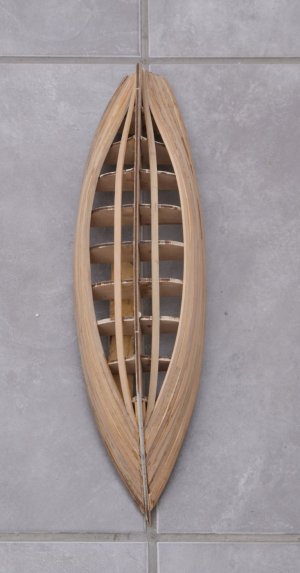
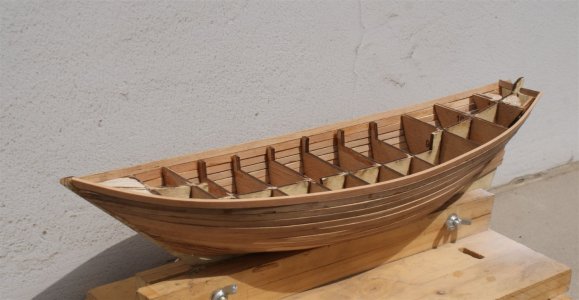
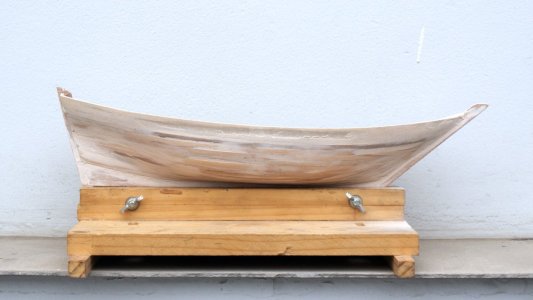
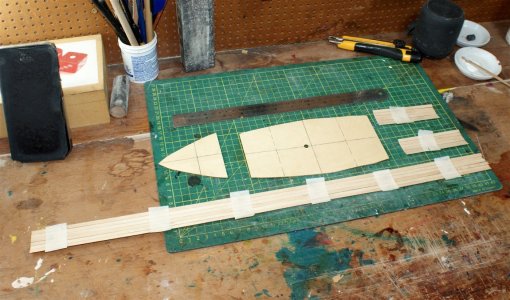
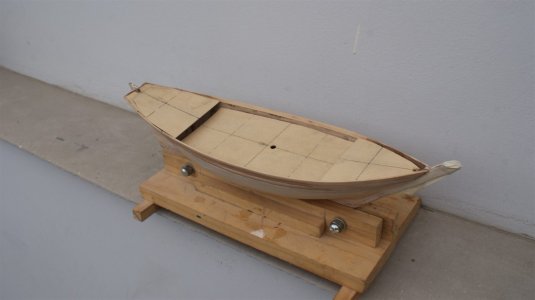
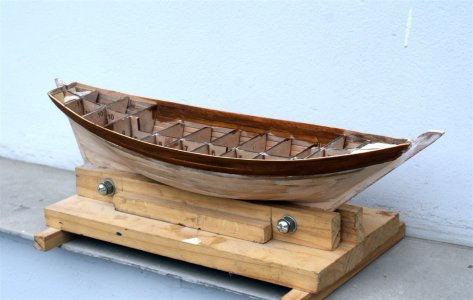
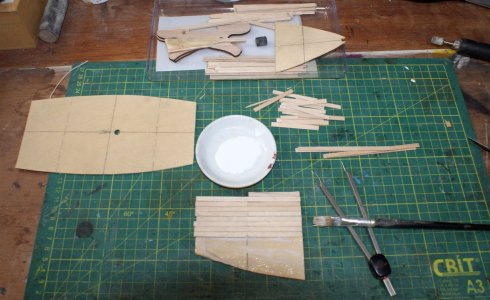
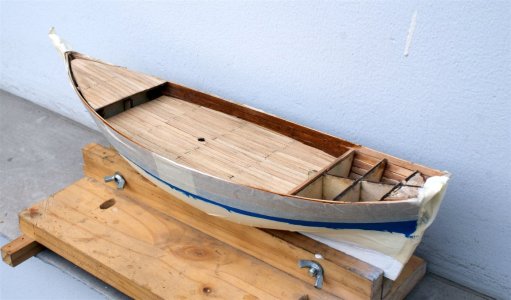
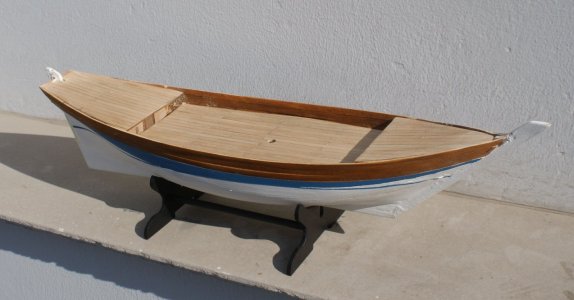
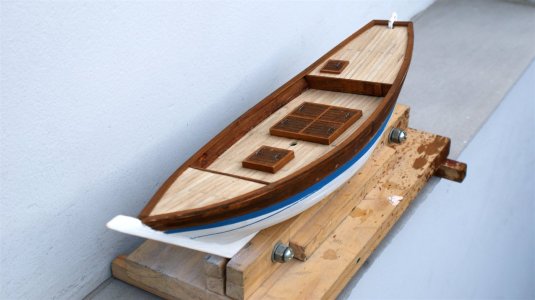
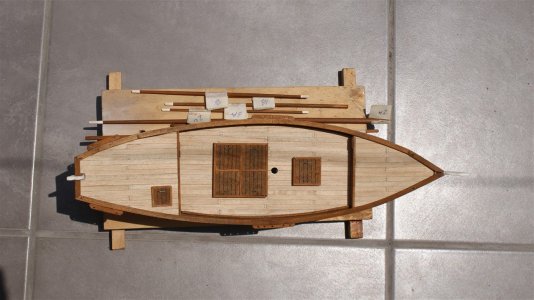
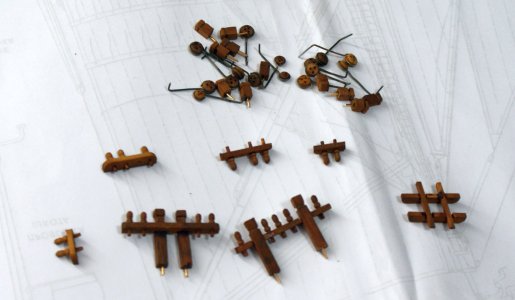
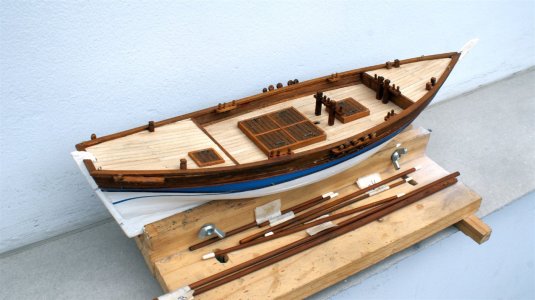

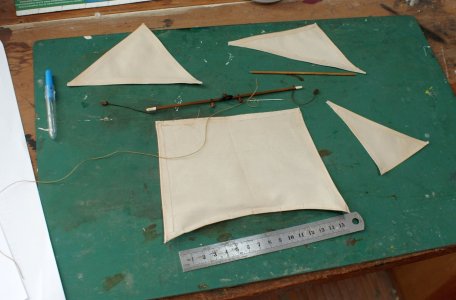

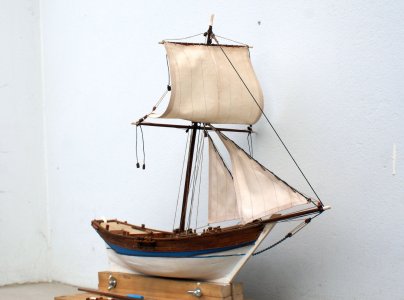
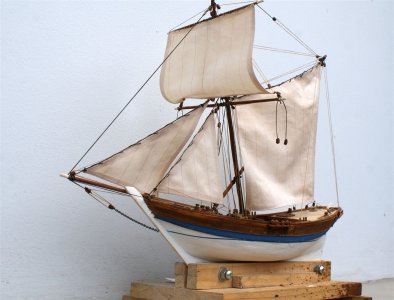

TSERNIKI-SACOLEVA (1 rst Part)
Introduction
“From the 18th century to the first half of the last century, it was easy to find ships with unmistakable rigging, the main component of which was a large tarquin sail (tarchia), in the eastern Mediterranean, on the southern coast of Anatolia, Syria and Egypt, and in the Black Sea and the Adriatic. And anyone who knew one of them could get an “unforgettable impression”; it is really scary when a strong wind blows and all the ships cautiously take the reefs; to see them sailing at full sail, overcoming the waves like a thoroughbred horse jumping over the hedge, running so fast in the wind that it makes you think it can no longer right itself... ". These lines are from Auguste Jal. What Captain Henrique said about it "...Greek sailors are deservedly considered among the best in the world, and one feels that they passionately love their ships and their trade; On the schooner there is a mast with large sails and it is very fun to see them from a distance, as they deceive the eye and look like things from a fairy tale. 15-meter boats (the size of the lifeboats of the great ships of the past) are equipped with several sails, double topsails, foresails, three or four jibs, this little boat that looks like a nutshell, wants to look like a three-deck ship and triumphs in its small size with a captivating grace…"
This is how the article "La Sacoleva" by Sergio Bellabarba and Girgio Osculati begins, where this beautiful boat is described in detail, its history is narrated, its usual dimensions, the use it had, as well as the name that in some places it was given: Tserniki, Sacoleva, Sakoleva or Sacoleve (so named by Vice-Admiral Paris in his book Souvenirs de Marine. Collection de Plans ou Dessins de Navires).
For the purposes of this project, the plan GRECE-SACOLEVE-1835 by Vice-Admiral Francios-Edmond Paris has been taken as a basis, as well as details of the article "La Sacoleva" by Bellabarba-Osculati, and others from the references mentioned here
References

Making the model
The first photo shows several ships anchored in port, in one of them you can see the main mast vertically with the yards with sails furled; in the other photo a schooner without a mizzen; then, the rigging was variable and depended a lot on which part of the Mediterranean or Adriatic the ship was. The other photos are the beginning of the article "The Schooner", it is in Italian, but with some effort it was possible to extract details. Also included is the plan of the "Atlas du Genie Maritime" that was used as a base.
From the plans shown and their hull lines, the sections for the frames were obtained, from the plan view, the shape of the deck and the dimensions of the rigging. It was drawn in AutoCAD and the frames and main parts were laser cut on 4 mm and 1.5 mm plywood sheets, The dimensions of minor elements were taken to the scale of the same plans.
For the hull, 2x5 mm cedar planks were used and glued onto the frames. As the plans don't show much detail, by mistake the planks were made to reach the keel, but the ship should have been a flat mirror, which was rectified. 3x5 mm wooden strips were glued for the sternpost, keel and stem. Afterwards, the hull was brushed and sanded to eliminate protrusions and differences between the planks.
After a good sanding, it was sealed with a mixture of wood putty, shavings and white rubber, filling the joints and deficiencies of the first skin; The hull was then sanded with 100, 150 and 225 grit sandpaper and before the painting phase, a thinned lacquer was applied to stabilise the seal. After sealing the hull with lacquer, the entire surface was lightly sanded and the topsides were painted with several coats of white and light blue acrylic paint, leaving a strip of wood previously stained in mahogany.
The planking was made with 0.6x3x75 mm strips cut from a lupuna veneer which is a whitish local wood. The edges were blackened with pencil lead and glued to the deck piece in a 2-by-2 arrangement; the nailing was simulated with the tip of a hard pencil, then sanded and aged with "Judean bitumen". The hold entrances were prepared and glued to the deck. The gunwale, the gunwale cover (2x5 mm), and the garrison tables were also prepared and fixed, all of them stained in mahogany. The length and variation in diameter of the masts were measured, and the mizzen, mizzen boom, mainmast, bowsprit, yards and yardarm were prepared, all of the pieces were stained in mahogany; some ends were painted in white. 1mm mahogany-coloured strips were placed on the sides of the hull
Then the other deck elements were prepared, such as the garrison tables, bitts, jacks, cleats, chain chinstrap, etc. All the wooden elements were stained honey-coloured. For the sails, the dimensions of the available plans were taken, giving them a margin for the fold, these were prepared with cotton cloth, dyed with tea. The seams were simulated with lines drawn with a pencil and the edges were reinforced with a cotton thread. Two jibs were made, a topsail, a tarquin and the mizzen jib.
The topsail was first placed on the already fixed yards, the two stays were installed towards the bowsprit and the two jibs were mounted. The plans available for this boat are not sufficient; they can be used to make the hull, deck and masts, but they are vague and uncertain in the placement of the ropes, stays, shrouds in the rigging, and in the fixing of the yard. Regarding this point, I have to thank Javier Barón who illustrated me with some diagrams that I used in this model.
After fixing the yardarm, the tarquin sail and other elements were mounted on the masts. We used two gauge thread, one thick for the stays and shrouds, made of braided cotton that was darkened and waxed with Judea bitumen, the other of undyed beige cotton that has been used for the ropes. The shrouds were installed by fixing them to the beams and checking again the alignment and inclination of the masts. Finally, the rudder blade and tiller were placed at anchor with its chain and rope. The final touches of paint were applied.



























